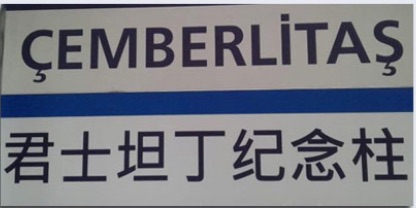Should there be a Constantine Memorial Column in Istanbul?
« previous post | next post »
Sign for a tram stop in Istanbul:

The word on top is Turkish for "hooped column". The words below are "Jūnshìtǎndīng jìniàn zhù 君士坦丁紀念柱" ("Constantine Memorial Column"). Thereby hangs a tale.
The illustration above is from Oda TV news, which is sort of an opposition paper, quite nationalistic. The accompanying article explains:
As a sign of friendship between the Istanbul Municipality and the Chinese government, tram stops in the old city displayed Turkish and Chinese names. Conservatives and ultra nationalists objected to the fact that the Chinese said ‘Constantine Column’ rather than something like the Turkish for it, hooped column [iron hoops surrounding the column to protect it from further deterioration in the 17th cc]. Referring to ‘Constantine’ further implies ‘Constantinople’, denying the city has been Turkish since 1453….
To adjudicate the matter, we need to look at the origins of the column (from Wikipedia):
The Column of Constantine (Turkish: Çemberlitaş Sütunu, from çemberli 'hooped' and taş 'stone'), also known as the Burnt Stone or the Burnt Pillar, is a Roman monumental column constructed on the orders of the Roman emperor Constantine the Great in 330 AD. It commemorates the declaration of Byzantium (renamed by Constantine as Nova Roma) as the new capital city of the Roman Empire. The column is located on the Street of the Janissaries (Yeniçeriler Caddesi) in the neighborhood (named after the column) of Çemberlitaş, central Istanbul, along the old Road to the Imperial Council (Divan Yolu) between the Hippodrome of Constantinople (now Sultanahmet Square) and the Forum of Theodosius (now Beyazıt Square).
Beyond that, we should examine the long, involved history of this 35 meters (originally 50 meters) high column made of porphyry blocks that were surmounted by a statue of Constantine in the figure of Apollo. But that would then require us to consider the fate of Hagia Sophia (why is it still called that instead of Ayasofya Müzesi?), and much else besides.
It might be simplest just to call the column "burnt stone".
[Thanks to Erika Gilson]
Thaomas said,
October 9, 2019 @ 9:25 am
We all need to make these little adjustments for the convenience of our new Chinese hegemon. :)
J.W. Brewer said,
October 9, 2019 @ 1:45 pm
The city retained the official name "Constantinople" (or the equivalent in various other languages) for approx. 470 years after 1453. Post-Ottoman Kemalist nationalism is rather less cosmopolitan in various regards than the Ottoman regime was, which is what it is (I mean that as a neutral description rather than a value judgment), but when it contrasts itself with the Ottoman approach in a way that suggests that the Ottomans were affirmatively anti-Turkish (rather than merely choosing to manifest their Turkishness in a different style) it can appear a bit ridiculous.
https://tr.wikipedia.org/wiki/Konstantinopolis
matt regan said,
October 10, 2019 @ 12:05 pm
I guess they just like it better that way
Victor Mair said,
October 10, 2019 @ 12:13 pm
Who do you mean by "they"?
matt regan said,
October 10, 2019 @ 1:23 pm
The Four Lads
Victor Mair said,
October 10, 2019 @ 2:51 pm
Please speak to the post or stop commenting.
J.W. Brewer said,
October 10, 2019 @ 3:24 pm
Prof. Mair, I suspect Mr. Regan was alluding to a lyric from an arguably-on-topic song from (in this version) 1953: https://www.youtube.com/watch?v=Wcze7EGorOk.
matt regan said,
October 11, 2019 @ 9:45 am
Um, yes.
Particularly apposite, I thought.
The whole lyric I (mis)quoted is
"Even Old New York, was once New Amsterdam,
Why did they change it? I can't say:
People just liked it better that way.
But now it's Istanbul, etc,etc."
Levantine said,
October 11, 2019 @ 8:37 pm
"But that would then require us to consider the fate of Hagia Sophia (why is it still called that instead of Ayasofya Müzesi?), and much else besides."
Why "instead of"? Ayasofya and Hagia Sophia are one and the same name.
Victor Mair said,
October 11, 2019 @ 11:51 pm
I knew that they mean the same thing, but they are not identical.
Levantine said,
October 12, 2019 @ 12:12 am
Ayasofya is a close Turkish approximation of Hagia Sophia. It's hard to imagine how the Greek pronunciation could be more faithfully captured in Turkish. Of course they're not identical (neither are the English and French pronunciations of Paris), but they're obviously related in a way that Çemberlitaş and Column of Constantine aren't at all.
Victor Mair said,
October 12, 2019 @ 8:06 am
That's all so obvious. We don't need you to tell us what we see plainly with our own eyes.
Levantine said,
October 12, 2019 @ 2:30 pm
It’s also worth noting that Ayasofya has no semantic value in Turkish and in that sense does not mean the same thing as Hagia Sophia. Rather than retaining any association with Divine Wisdom, the Ottoman rendering became something of a byword for converted cathedrals in general, being applied even to those that never bore the Greek dedication to begin with.
Bathrobe said,
October 13, 2019 @ 1:48 am
I find it interesting that despite fierce anti-colonialism on its home turf and determination to set its own narrative, China sees the rest of the world largely through the lens of the West. Chinese Wikipedia gives both 君士坦丁纪念柱 (Constantine's memorial pillar) and 被烧之柱 (burnt pillar) as names for the pillar, but China has chosen the former for this sign. It's hard not to be just a little bit cynical.
Levantine said,
October 13, 2019 @ 2:13 am
How is it a Western lens? It is indeed the Column of Constantine–that is the most descriptive and accurate name we have for the monument. "Burnt Pillar" is itself a Western label, unrelated in meaning to the Turkish name.